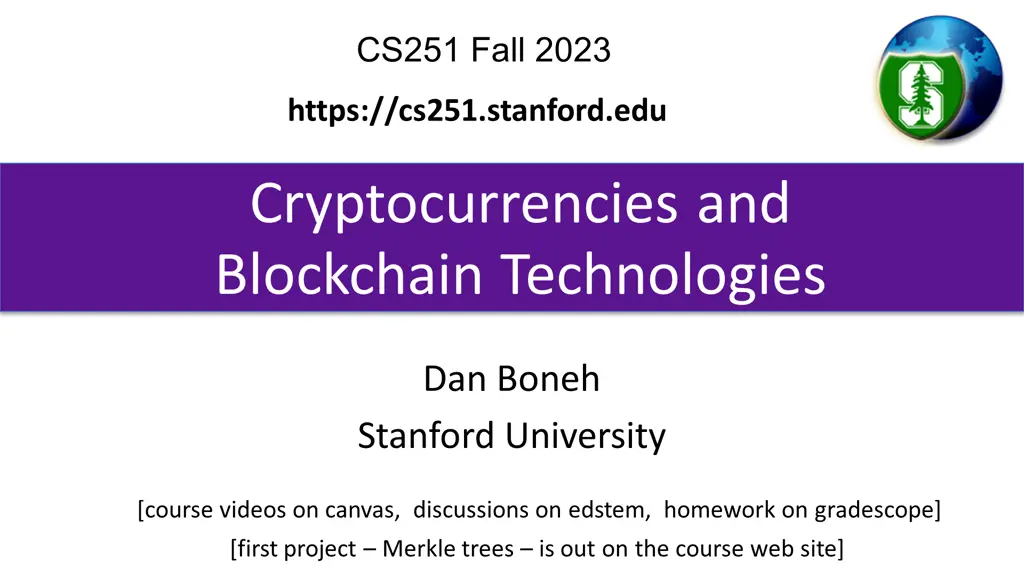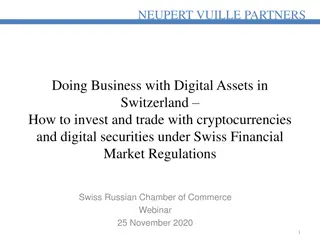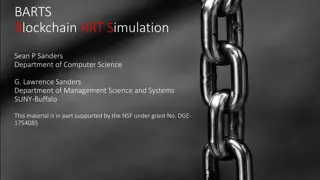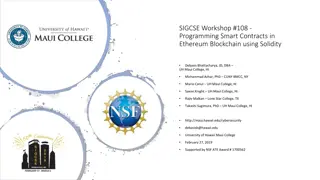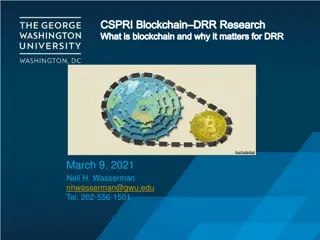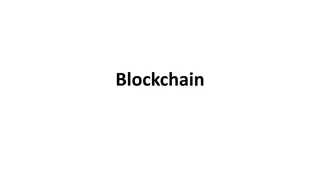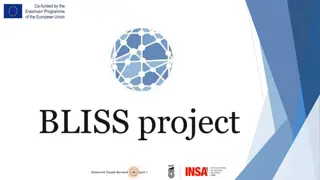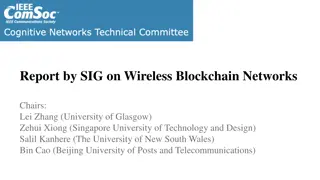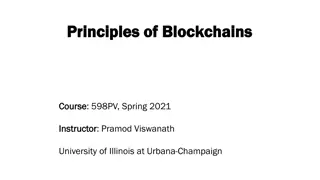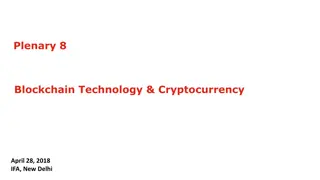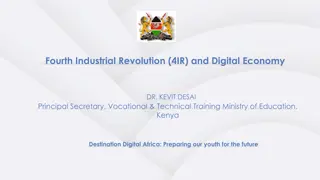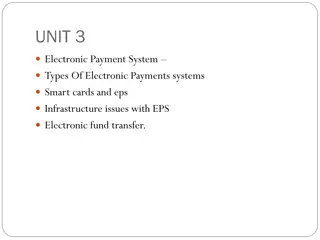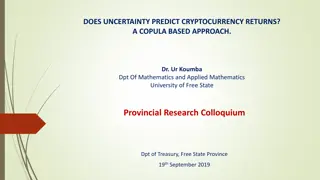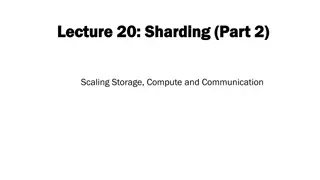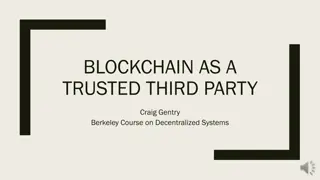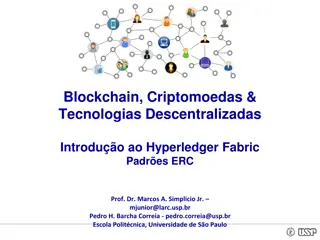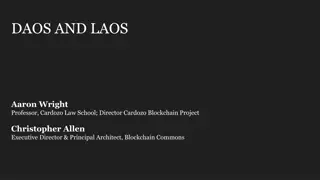Cryptocurrencies and Blockchain Technologies
Join the CS251 course at Stanford University to learn about cryptocurrencies and blockchain technologies. Access course videos on Canvas, participate in discussions on Edstem, and complete homework on Gradescope. Explore the first project on Merkle trees available on the course website.
- Cryptocurrencies
- Blockchain Technologies
- Stanford University
- Merkle trees
- course videos
- discussions
- homework
Download Presentation

Please find below an Image/Link to download the presentation.
The content on the website is provided AS IS for your information and personal use only. It may not be sold, licensed, or shared on other websites without obtaining consent from the author. Download presentation by click this link. If you encounter any issues during the download, it is possible that the publisher has removed the file from their server.
E N D
Presentation Transcript
CS251 Fall 2023 https://cs251.stanford.edu Cryptocurrencies and Blockchain Technologies Dan Boneh Stanford University [course videos on canvas, discussions on edstem, homework on gradescope] [first project Merkle trees is out on the course web site]
What is a blockchain for? Abstract answer: a blockchain provides coordination between many parties, when there is no single trusted party if trusted party exists no need for a blockchain
What is a blockchain? Abstract answer: a blockchain provides coordination between many parties, when there is no single trusted party if trusted party exists no need for a blockchain [financial systems: often no trusted party]
Blockchains: what is the new idea? 2009 Bitcoin Several innovations: A practical public append-only data structure, secured by replication and incentives A fixed supply asset (BTC). Digital payments, and more.
Blockchains: what is the new idea? 2009 2015 Bitcoin Ethereum Several innovations: Blockchain computer: a fully programmable environment public programs that manage digital and financial assets Composability: applications running on chain can call each other
Blockchains: what is the new idea? 2009 2015 2017 2022 Bitcoin Ethereum growth of DeFi, NFTs, DAOs
So what is this good for? (1) Basic application: a digital currency (stored value) Current largest: Bitcoin (2009), Ethereum (2015) Global: accessible to anyone with an Internet connection
What else is it good for? (2) Decentralized applications (DAPPs) DeFi: financial instruments managed by public programs examples: stablecoins, lending, exchanges, . Asset management (NFTs): art, game assets, domain names. Decentralized organizations (DAOs): (decentralized governance) DAOs for investment, for donations, for collecting art, etc. (3) New programming model: writing decentralized programs
Assets managed by DAPPs StableCoin $4.5B Exchange $2.2B Lending $2.3B V3 $3.1B Exchange V3 Lending $1.8B Sep. 2023
Transaction volume 24h volume Sep. 2023 $9.9B $3.4B $2.7B
# Active developers since launch (as of 12/31/2022) source: electric capital
What is a blockchain? user facing tools (cloud servers) applications (DAPPs, smart contracts) Execution engine (blockchain computer) Sequencer: orders transactions Data Availability / Consensus Layer
Consensus layer (informal) achieved by replication A public append-only data structure: Persistence: once added, data can never be removed* Safety: all honest participants have the same data** Liveness: honest participants can add new transactions Open(?): anyone can add data (no authentication) Data Availability / Consensus layer
How are blocks added to chain? blockchain I am the leader signed 6.25 BTC skA verify block verify block skB skC
How are blocks added to chain? blockchain I am the leader 6.25 BTC skA skB 6.25 BTC skC
Why is consensus a hard problem? Tx1, Tx2, Tx3, Tx4 Tx1, Tx2, Tx3, Tx4 Tx1 Tx3 The good case: copies are consistent Tx4 Tx2 Tx1, Tx2, Tx3, Tx4 Tx1, Tx2, Tx3, Tx4
Why is consensus a hard problem? Tx3, Tx4, Tx1, Tx2 Tx1, Tx2, Tx3, Tx4 Tx1 Tx3 -delay Problems: Network delays can affect Tx order Tx4 Tx2 -delay Tx1, Tx2, Tx4, Tx3 Tx4, Tx3, Tx1, Tx2
Why is consensus a hard problem? Tx3, Tx4 Tx1, Tx2 Tx1 Tx3 Problems: Network delays Network partition network partition Tx4 Tx2 Tx1, Tx2 Tx3, Tx4
Why is consensus a hard problem? Tx1, Tx2, Tx4 crashed Tx1 Tx3?? Problems: crash Tx4 Tx2 Tx1, Tx2, Tx4 Tx1, Tx2, Tx4
Why is consensus a hard problem? ??? Tx1 Problems: crash malice Consensus protocols: next week Tx4 Tx2 ??? ???
Next layer: the blockchain computer Decentralized applications (DAPPs): Run on blockchain: code and state are written on chain Accept Tx from users state transitions are recorded on chain DAPP on-chain state DAPP DAPP blockchain computer Data availability / Consensus layer
Next layer: the blockchain computer Top layer: user facing servers end user DAPP on-chain state DAPP DAPP blockchain computer Data availability / Consensus layer
Lots of experiments: [source: the Block Genesis]
This course Cryptography Distributed systems Economics
Course organization 1. The starting point: Bitcoin mechanics 2. Consensus protocols 3. Ethereum and decentralized applications 4. DeFi: decentralized applications in finance 5. Private transactions on a public blockchain (SNARKs and zero knowledge proofs) 6. Scaling the blockchain: getting to 10K Tx/sec 7. Interoperability among chains: bridges and wrapped coins
Course organization cs251.stanford.edu Homework problems, projects, final exam Optional weekly sections on Friday Please tell us how we can improve Don t wait until the end of the quarter
Cryptography Background (1) cryptographic hash functions An efficiently computable function ?: ? ? where |?| |?| 32 bytes ? = 0,1256 megabytes hash value
Collision resistance Def: a collision for ?:? ? is pair ? ? ? s.t. ?(?) = ?(?) |?| |?| implies that many collisions exist Def: a function ?:? ? is collision resistant if it is hard to find even a single collision for ? (we say ? is a CRF) Example: SHA256: {? : len(?)<264bytes} {0,1}256 (output is 32 bytes) details in CS255
Application: committing to data on a blockchain Alice has a large file ?. She posts = ?(?) (32 bytes) Bob reads . Later he learns ? s.t. ?(? ) = ? is a CRF Bob is convinced that ? = ? (otherwise, ? and ? are a collision for ?) We say that = ?(?) is a binding commitment to ? (note: not hiding, may leak information about ?)
Committing to a list (of transactions) 32 bytes Alice has ? = (?1,?2, ,??) Goal: - Alice posts a short binding commitment to ?, = commit(?) - Bob reads . Given ??, proof ? can check that ?[?] = ?? Bob runs verify ,?,??, ? accept/reject security: adv. cannot find (?,?,?,?) s.t. ? ?[?] and verify( ,?,?,?) = accept where = commit(?)
Merkle tree (Merkle 1989) commitment Goal: commit to list S of size n Later prove ?[?] = ?? Merkle tree commitment ?1?2?3?4?5 ?6 ?7 ?8 list of values S
Merkle tree (Merkle 1989) [simplified] commitment Goal: commit to list S of size n Later prove ?[?] = ?? ?5 ?6 H H H ?1 ?2 ?3 ?4 To prove ? 4 = ?4 , proof = H H H H ?3,?1,?6 ?1?2?3?4?5 ?6 ?7 ?8 length of proof: log2 ? list of values S
Merkle tree (Merkle 1989) [simplified] To prove ? 4 = ?4 , proof = commitment ?3,?1,?6 ?5 ?6 H Bob does: ?2 ?(?3,?4) ?5 ?(?1,?2) ?(?5,?6) accept if = H H ?1 ?2 ?3 ?4 H H H H ?1?2?3?4?5 ?6 ?7 ?8 list of values S
Merkle tree (Merkle 1989) Thm: For a given ?: if ? is a CRF then adv. cannot find (?,?,?,?) s.t. S = n, ? ?[?], = commit ? , and verify( ,?,?,?) = accept (to prove, prove the contra-positive) How is this useful? To post a block of transactions ? on chain suffices to only write commit(?) to chain. Keeps chain small. Later, can prove contents of every Tx.
Abstract block chain blockchain block header Merkle root block header Merkle root block header Merkle root other data other data other data hash hash Merkle tree Merkle tree Merkle tree Tx1 Tx2 Txn Tx1 Tx2 Txn Tx1 Tx2 Txn Merkle proofs are used to prove that a Tx is on the block chain
Another application: proof of work Goal: computational problem that takes time (?) to solve, but solution takes time O(1) to verify (D is called the difficulty) How? ?:? ? {0,1,2, ,2? 1} e.g. ? = 256 puzzle: input ? ?, output ? ? s.t. ?(?,?) < 2?/? verify(?,?): accept if ?(?,?) < 2?/?
Another application: proof of work Thm: if H is a random function then the best algorithm requires ? evaluations of ? in expectation. Note: this is a parallel algorithm the more machines I have, the faster I solve the puzzle. Proof of work is used in some consensus protocols (e.g., Bitcoin) Bitcoin uses ?(?,?) = SHA256(SHA256(?.?))
Cryptography background: Digital Signatures How to authorize a transaction
Signatures Physical signatures: bind transaction to author Bob agrees to pay Alice 1$ Bob agrees to pay Alice 100$ Problem in the digital world: anyone can copy Bob s signature from one doc to another
Digital signatures Solution: make signature depend on document Signer Verifier accept or reject Bob agrees to pay Alice 1$ verifier signature signing algorithm public verification key (pk) secret signing key (sk)
Digital signatures: syntax Def: a signature scheme is a triple of algorithms: Gen(): outputs a key pair (pk, sk) Sign(sk, msg) outputs sig. Verify(pk, msg, ) outputs accept or reject Secure signatures: (informal) Adversary who sees signatures on many messages of his choice, cannot forge a signature on a new message.
Families of signature schemes 1. RSA signatures (old not used in blockchains): long sigs and public keys ( 256 bytes), fast to verify 2. Discrete-log signatures: Schnorr and ECDSA short sigs (48 or 64 bytes) and public key (32 bytes) (Bitcoin, Ethereum) 3. BLS signatures: 48 bytes, aggregatable, easy threshold (Ethereum 2.0, Chia, Dfinity) 4. Post-quantum signatures: long ( 600 bytes) details in CS255
Signatures on the blockchain Signatures are used everywhere: ensure Tx authorization, governance votes, consensus protocol votes. verify Tx verify Tx verify Tx sk1 data signatures sk2 data signatures
END OF LECTURE Next lecture: the Bitcoin blockchain
